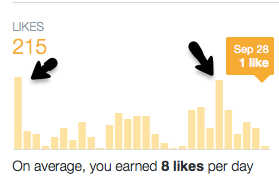Content is key for marketing, traffic, and search engine optimization. Content can convert wanna be buyers into lifelong customers if your efforts are thorough. With content being of the utmost importance, you don’t want to waste your efforts creating something that won’t actually achieve what you’ve set out to achieve.
You don’t need to be clairvoyant to determine what will play well with your audience. If you know where to look and what to consider, you’ll find that they’re telling you what they’re looking for. Basing your content strategy on what your audience wants and needs will deliver guaranteed results.
Developing that strategy is simple. By considering a few important areas of interest and using easy methods of tracking and observing data and comments, you’ll always find yourself one step ahead of your audience’s needs.
By Researching and Besting Your Competitors
Look at popular blogs in similar niches. What’s playing well with their audience? What are their followers liking, sharing, and commenting on? These are the kinds of posts that are already doing well, and you can learn a few lessons from them.
The goal is not to write the exact same content. It’s to offer fresh perspectives on the same ideas, similar resources, or content above and beyond what your competitors provide. If their successful posts are explaining a process, go above and beyond by providing a full tutorial.

People appreciate innovation. Innovating above and beyond what their expectations are might even help you poach audience members from your competitors. They’ll be more likely to recognize you as an authority, particularly if they’re able to glean more value from your content. Just take a great thing and make it even better.
By Spying On Your Own Social Media
If your website or business has an active social media presence, look at your engagement. What kind of people like you? Are they tech enthusiasts who love gaming and apps, or are they foodies who love to share cooking videos? Try to encompass as many of their interests as possible, tethering them to your main message.

You can also read the discussions your social media followers have in your comments. Back and forth commenting isn’t always senseless arguments – people might be openly discussing their pain points and debating them with each other. By being receptive to these pain points, you’ll understand the problems that your audience would like to see solved.
You can preemptively create solutions or explore issues from perspectives that your audience hasn’t even considered. They’ll feel enlightened, and they might want to share that enlightenment with their personal network. You can grow and reach further by providing that kind of help.
Through Keyword Research
Google has already done a ton of research about what people care about or are interested in. All you need to do is listen to their suggestions. You can use either generic or specific keywords that are relevant to your website (or more broadly, your entire niche) and see what’s trending. It might be slightly different from what you were expecting, but chances are that it will be relevant enough to easily translate into immediately desirable content.
You can also use Adwords and Related Keywords to develop your ideas even further. Related Keywords boasts some unique advantages. You’ll be able to see what people are searching for, particularly when it comes to long-tail keywords, and create content to satisfy their search. You’re likely to find areas where the competition is low. Take advantage of that opportunity to quickly climb to the top of Google’s ranks for those keywords.
Adwords is helpful, but it’s a little more limited in the insight it provides. You’ll understand what people are looking for, but it may not be instantly apparent what kind of content you can create to draw them in. Adwords is better for speculation or reinforcing strategies based on keyword research you’ve conducted through Google’s other tools.
By Anticipating Their Needs
If a new product or service is set to release in your niche, even if you’re the one releasing it, people are going to start looking for content about it. They want reviews, demos, tutorials, and explanations. A lot of people will seek these things out before making a purchasing decision. By knowing what’s coming up, you’re able to cement your authority on a particular topic before other websites swoop in. They’ll be getting their first look from you.

You can also offer help before people know they need it. If you’re aware of potential bugs or a high potential of user error with a product or service, you can resolve the issue before people even experience it. Your audience will inevitably be looking for these resources, even if it takes them a couple months to need troubleshooting. They won’t need to ask their peer group or poke around on forums to find what they need if you’ve already covered it.
Ask Directly
Many people have mixed feelings about leaving feedback or completing exit surveys. If you can boost the process with some kind of incentive or reward, more people will feel compelled to participate. Even if you can’t, you’re still likely to receive a few opinions here and there. Make sure you listen to them and implement reasonable requests that those people make. Even if you only get info back from 10% of people who visit, chances are that the other 90% of people would at least partially agree.
In addition to feedback you’ve received, check your own comments section below your content. If you don’t have comments enabled, it may be worthwhile to turn them on and hire a few monitors to manage them. People love leaving comments when they’re grumpy, and that makes it infinitely easy to discern what they’re so grumpy about.
They’ll tell you what they wish you did more of and what they wish you did less of. If you make any changes to your content that they don’t like, they’ll wax poetic about the old days. Your comments section is the best source of real time, easy to obtain, and useful feedback. You need to have one on your website – it’s virtually just as important as your social share buttons.
Use Your Own Tools
Your own blog metrics are one of the easiest things to use to create great content. What kinds of posts see the most engagement? What pieces are people still commenting on and sharing months after you’ve posted them? By using blog tools, you’ll get highly specific insight. This is great when you already have a large following that you’re attempting to maintain and grow. They already love some of the things you’re doing, and they want more of the things that they love. No strategy will ever be easier than following the results you’ve already seen.
Conclusion
The last part of a successful content strategy is to make sure people know that your content is what they need. Carefully select fonts and thumbnails when you’re creating that content to make sure they don’t inadvertently scroll right past it. The way that your content is presented has the potential to be equally as vital as the content itself.
Inevitably, you’ll make mistakes along the way and post a few duds, but that’s not what matters. As long as you keep considering the feedback that you’re getting and stay on top of your research, you’ll continue to create the right content at the right time.




[…] setting off to create a blog post you think your audience would like, research the topic to be doubly […]